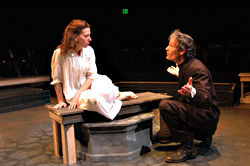The notorious case of Bridget Cleary is a true-crime tale well suited to the stage. Set in rural Ireland at the end of the 19th century, when people still paid heed to fairy folk, it’s got atmosphere (forgive me) to burn. And the facts of the case, though fairly well known, are as compelling now as then. Simply: Cleary was tortured and killed by her husband and other relations, who believed she was possessed by fairies.
In the new play Burning Bridget Cleary, playwright Allison Gregory (author of Forcing Hyacinths and Seattle Children’s Theatre’s current production of Peter and the Wolf) relays the story, for the most part effectively, through newspaper headlines, courtroom scenes, and flashbacks to the fateful events in Ballyvadlea. We watch as Bridget’s husband first discovers her ill and feverish, then begins to suspect she’s bewitched, then forces her to drink bitter herbs and testify that she is indeed his wife. The violence escalates until the authorities find poor Bridget in a boggy grave.
Grim, yes, but Gregory and director Sheila Daniels manage to leaven the story with a bit of Irish blarney and braggadocio. They stage it in the round with few sets, simple but believable costumes, and a large cast, all appealing (particularly Kate Wisniewski as Bridget, Michael Patten as her husband, Charles Leggett as his co-conspirator, and Darragh Kennan as an overzealous town authority). Apart from a few rough edges (to be expected in a new play), it adds up to a taut and engaging two hours.
Now for those edges. Burning Bridget Cleary brings to mind The Crucible, partly due to its subject matter, partly because of the inexorability with which the story unfolds. But in Arthur Miller’s play, the central character deliberately chooses death rather than falsely confessing to witchcraft. Bridget’s intentions are much less clear: Does she refuse to say the words that would save her because she’s delirious with fever? Because she’s had enough of her husband’s bullying? Because she really is possessed?
Gregory doesn’t want to offer any clear answers, obviously, but certain inconsistencies left me feeling confused rather than intrigued. For instance, Bridget, though considered by some characters to be on her deathbed, looks strong and fierce as an alley cat. Nor does it help that some of the torture scenes are too gingerly choreographed, as though the director were afraid someone onstage might get hurt.
My other quibble with the script is its occasional foray into then-current events—not unwarranted, but somewhat awkwardly handled. The Bridget Cleary case had political ramifications; English authorities took it as evidence that the Irish were too backward to govern themselves. But when in the play an Irish ceili (or storytelling session) turns into an argument over home rule, the debate seems forced. None of this should deter you from skipping the next episode of CSI in favor of Burning Bridget Cleary, however. It’s a haunting Irish ghost story, well told.








